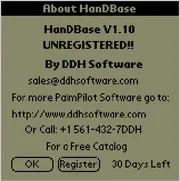The Internet Archive has hundreds of full usable Palmpilot apps that you can run in your browser

This really brings back memories, and I was even able to run the HanDBase app, which was a database app you could use to easily create a database with properly defined fields etc. The apps all run in proper Palmpilot or Palm OS emulators, so you do get the actual feeling of using the device right down to the Graffiti writing (which took me a few minutes to get used to again (it’s been a good 30 years since I last used a Palmpilot).
Partly the power behind Palm was the ability to install 3rd party community apps, and there were really some very good ones. It may look awfully simple today but that was the limitation of the graphics and devices of the time. This was long before smartphones and up to this point we mostly only had dumb fixed ROM pocket organisers.
See archive.org/details/softwareli…
#Blog, #palmpilot, #retro, #technology


